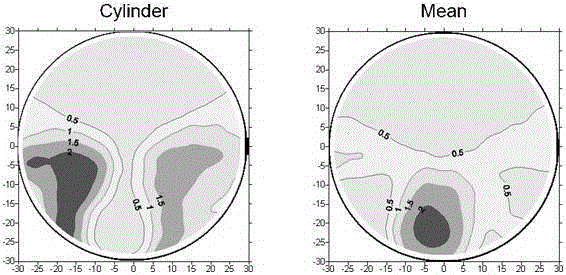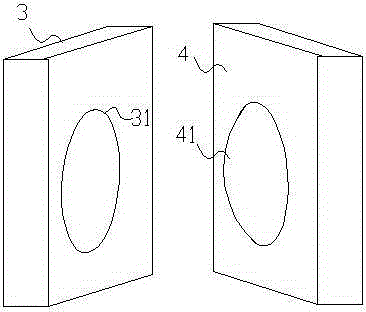Wide-screen intelligent presbyopic lens and its preparation mold
An intelligent, wide-screen technology, applied in glasses/goggles, optics, instruments, etc., can solve problems such as discomfort, difficult to adapt to glasses, and inability to meet the visual needs of middle-aged and elderly people
- Summary
- Abstract
- Description
- Claims
- Application Information
AI Technical Summary
Problems solved by technology
Method used
Image
Examples
Embodiment 1
[0071] ADD75 widescreen intelligent presbyopia lens free-form surface design
[0072] see figure 2 and image 3 , a wide-screen intelligent presbyopic lens, comprising a front surface 1 and a rear surface 2, both of the front surface and the rear surface are free-form surfaces, and the free-form surfaces include a far-sighted area, a near-sighted area, and a The gradient zone between the near and near zones.
[0073] The curved surface of the viewing distance zone is a polynomial surface, and the shape of the curved surface of the viewing distance zone is determined by the following function:
[0074] Z sy = C sy ( x 2 + y 2 ) 1 + ...
Embodiment 2
[0141] ADD100 widescreen intelligent presbyopia lens free-form surface design
[0142] see figure 2 and image 3 , a wide-screen intelligent presbyopic lens, comprising a front surface 1 and a rear surface 2, both of the front surface and the rear surface are free-form surfaces, and the free-form surfaces include a far-sighted area, a near-sighted area, and a The gradient zone between the near and near zones.
[0143] The curved surface of the viewing distance zone is a polynomial surface, and the shape of the curved surface of the viewing distance zone is determined by the following function:
[0144] Z sy = C sy ( x 2 + y 2 ) 1 + ...
Embodiment 3
[0207] ADD150 widescreen intelligent presbyopia lens free-form surface design
[0208] see figure 2 and image 3 , a wide-screen intelligent presbyopic lens, comprising a front surface 1 and a rear surface 2, both of the front surface and the rear surface are free-form surfaces, and the free-form surfaces include a far-sighted area, a near-sighted area, and a The gradient zone between the near and near zones.
[0209] The curved surface of the viewing distance zone is a polynomial surface, and the shape of the curved surface of the viewing distance zone is determined by the following function:
[0210] Z sy = C sy ( x 2 + y 2 ) 1 + ...
PUM
 Login to View More
Login to View More Abstract
Description
Claims
Application Information
 Login to View More
Login to View More - R&D
- Intellectual Property
- Life Sciences
- Materials
- Tech Scout
- Unparalleled Data Quality
- Higher Quality Content
- 60% Fewer Hallucinations
Browse by: Latest US Patents, China's latest patents, Technical Efficacy Thesaurus, Application Domain, Technology Topic, Popular Technical Reports.
© 2025 PatSnap. All rights reserved.Legal|Privacy policy|Modern Slavery Act Transparency Statement|Sitemap|About US| Contact US: help@patsnap.com



